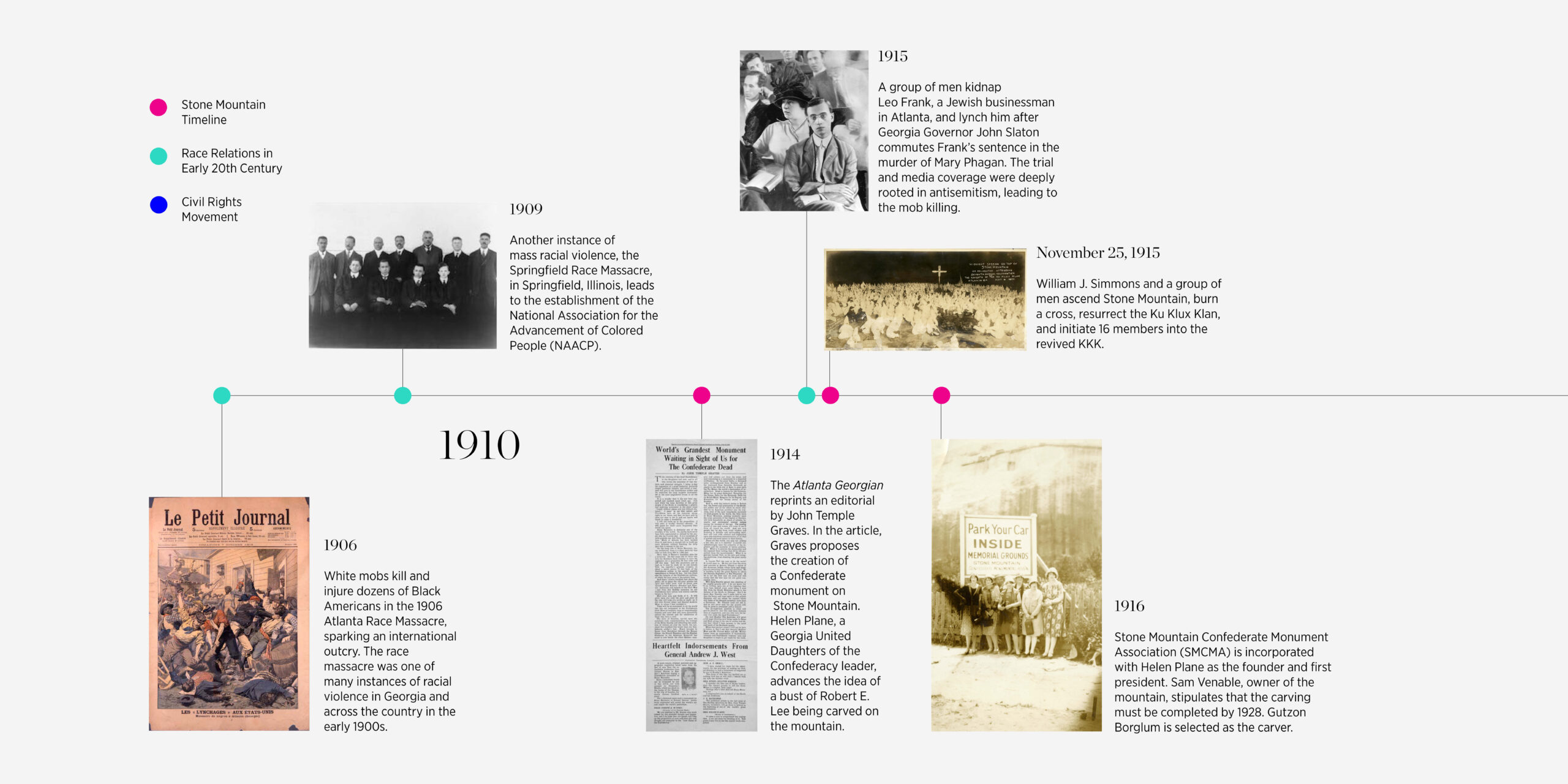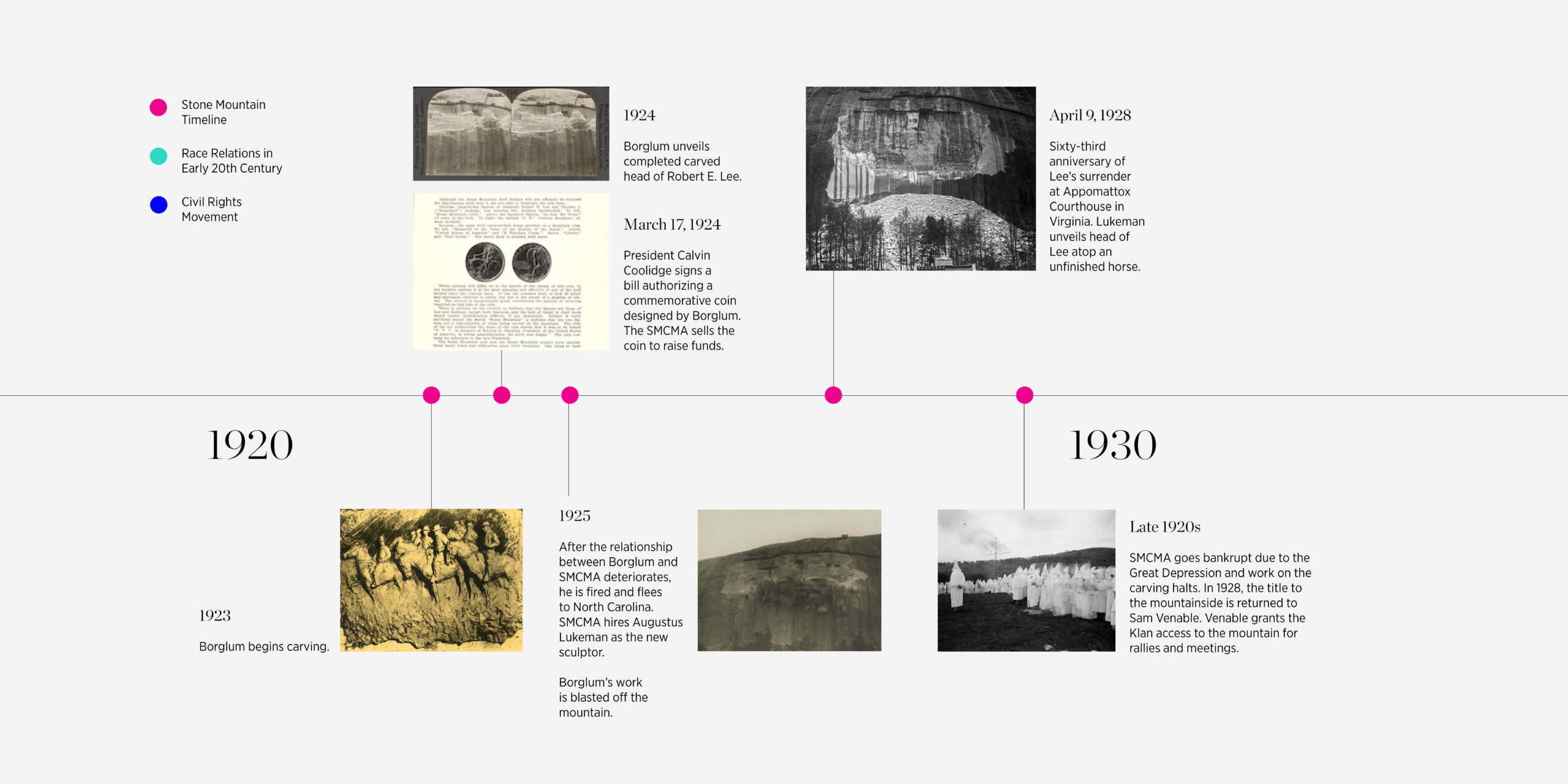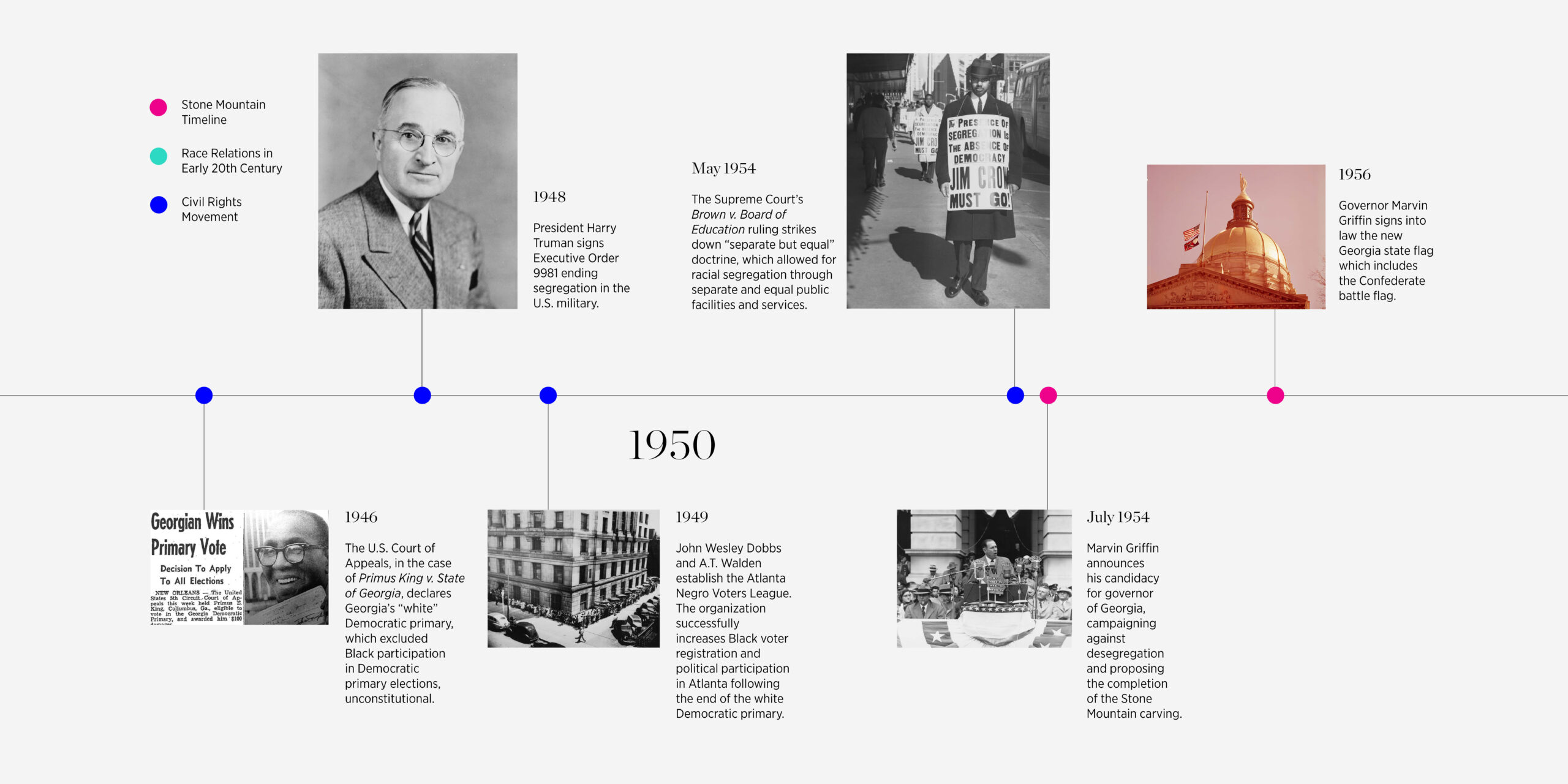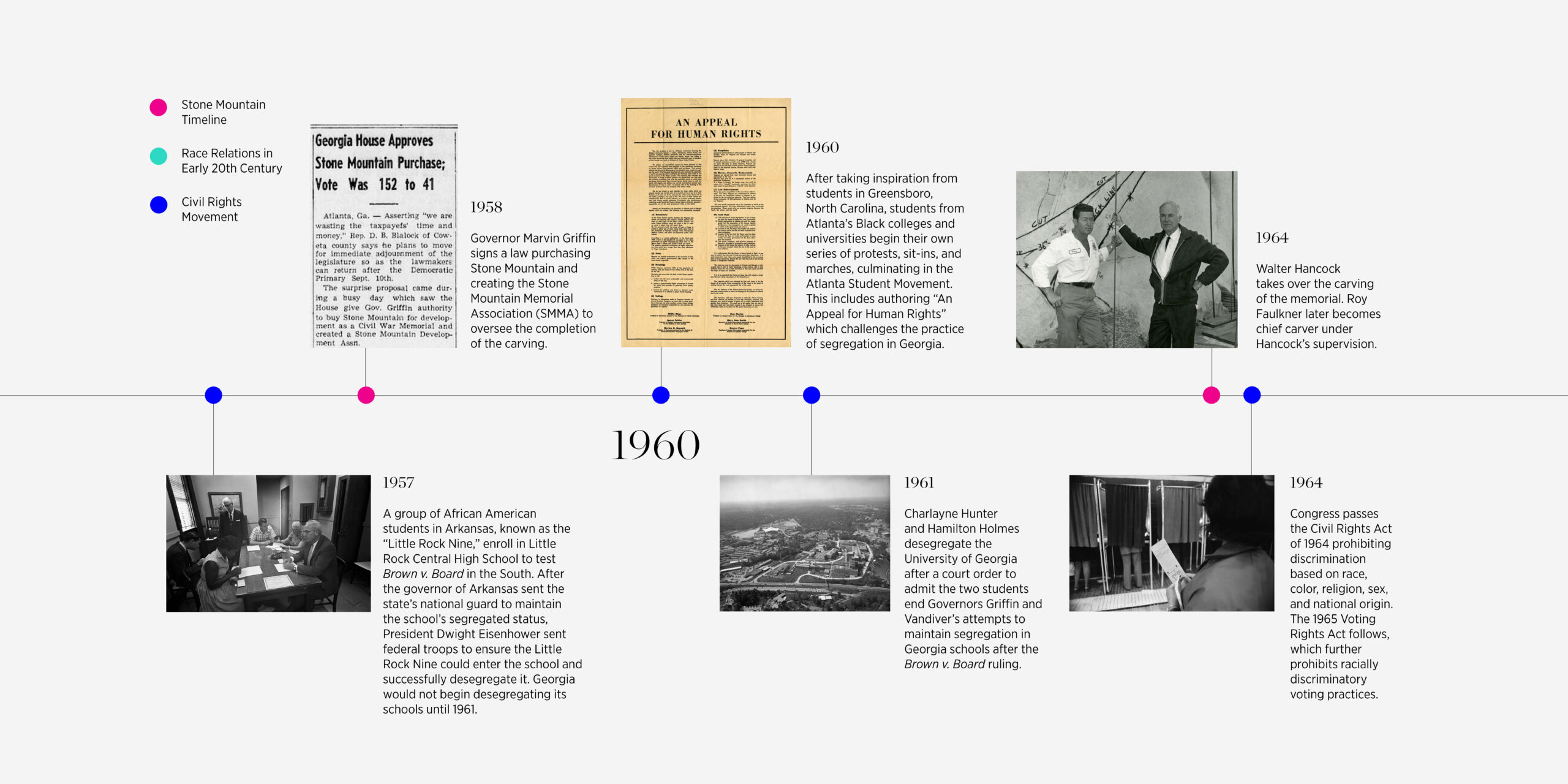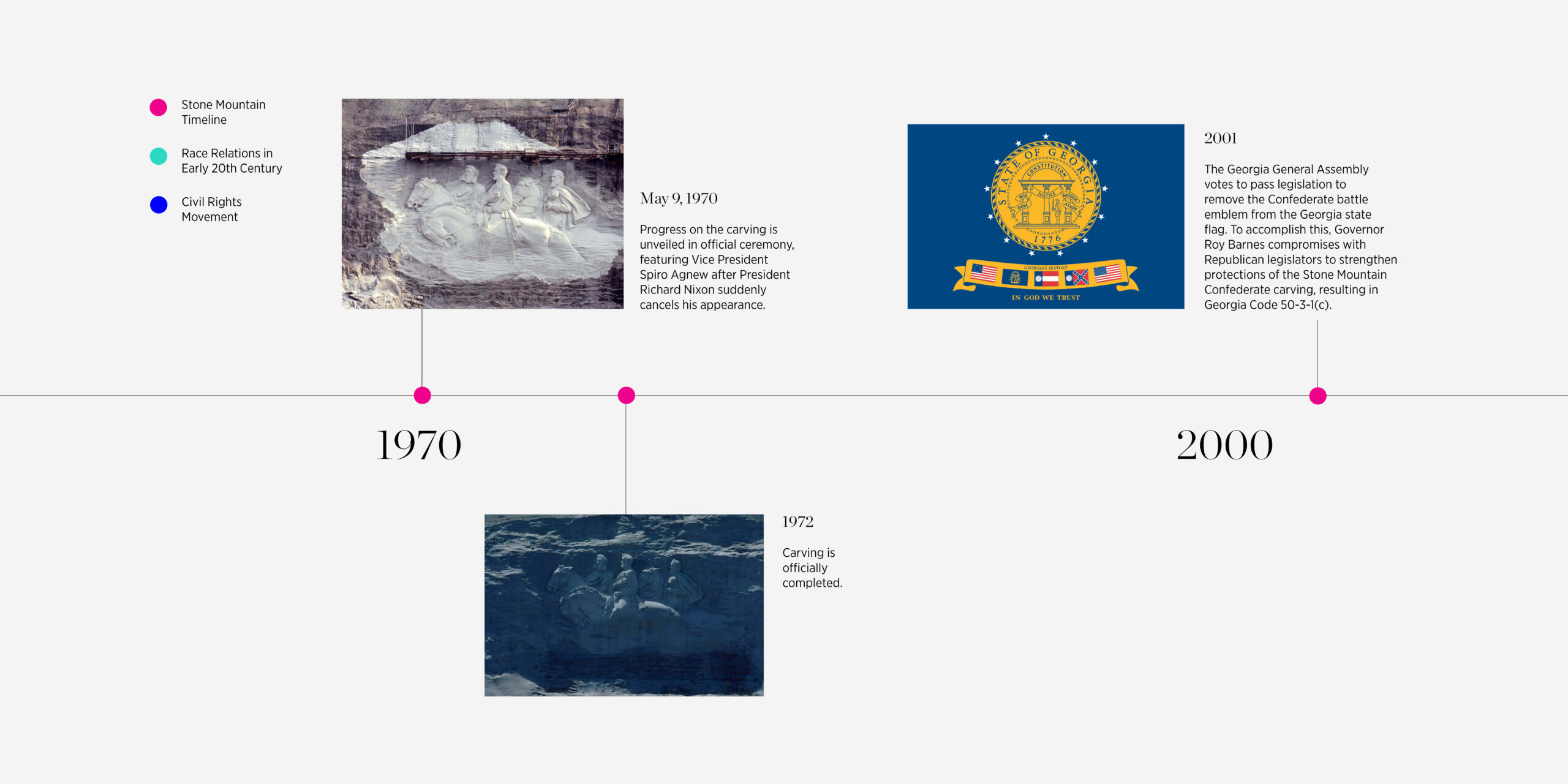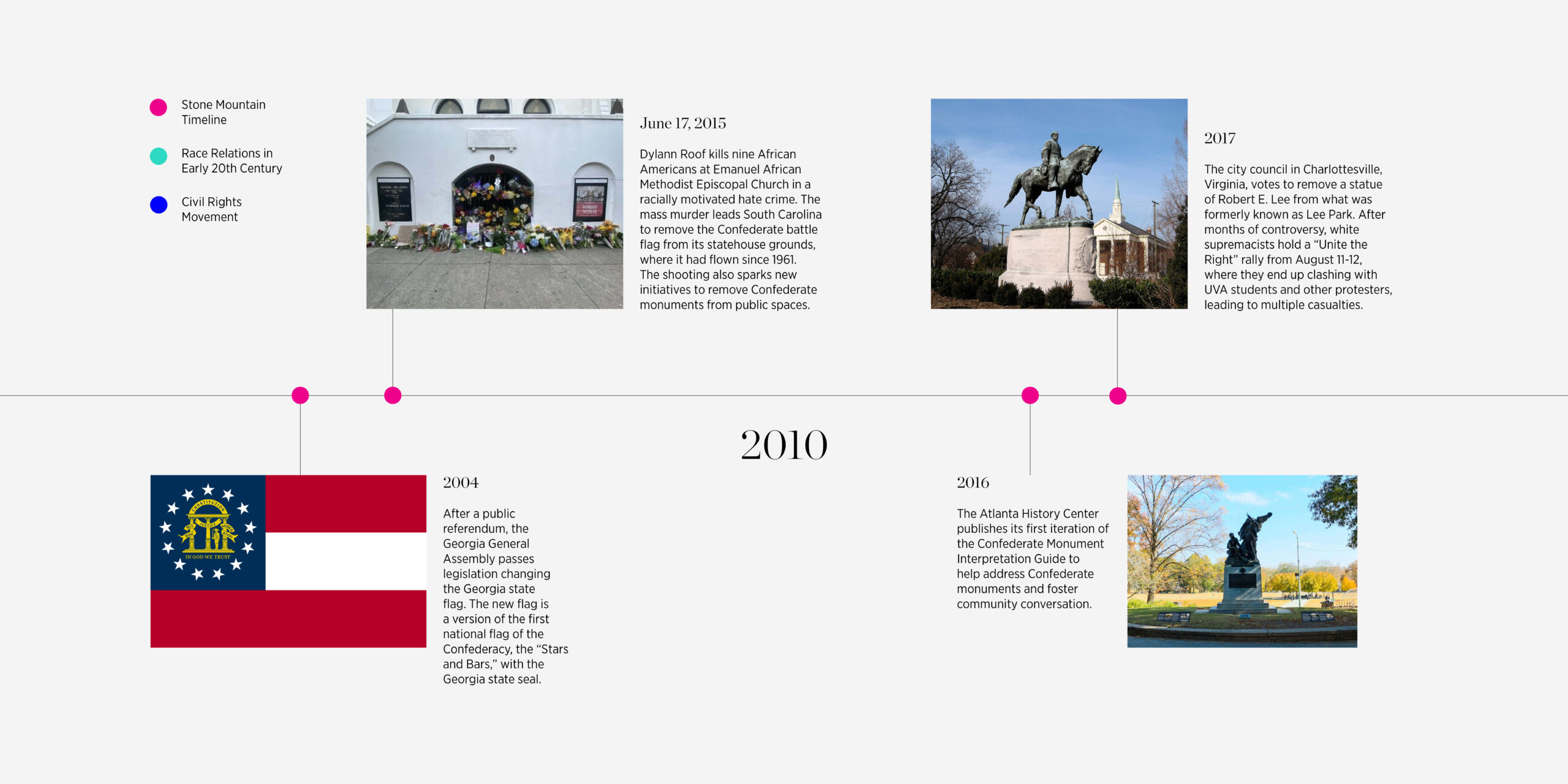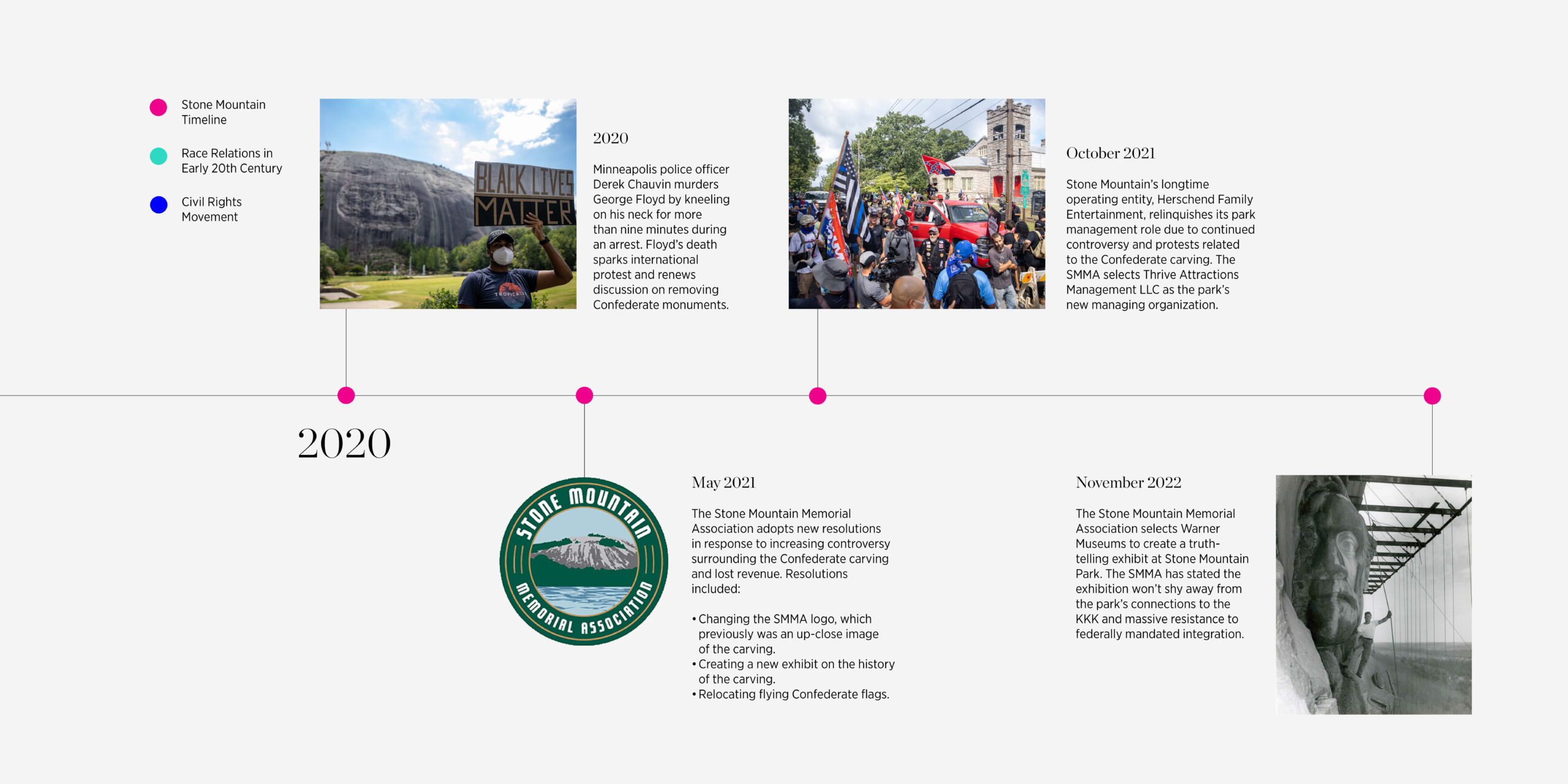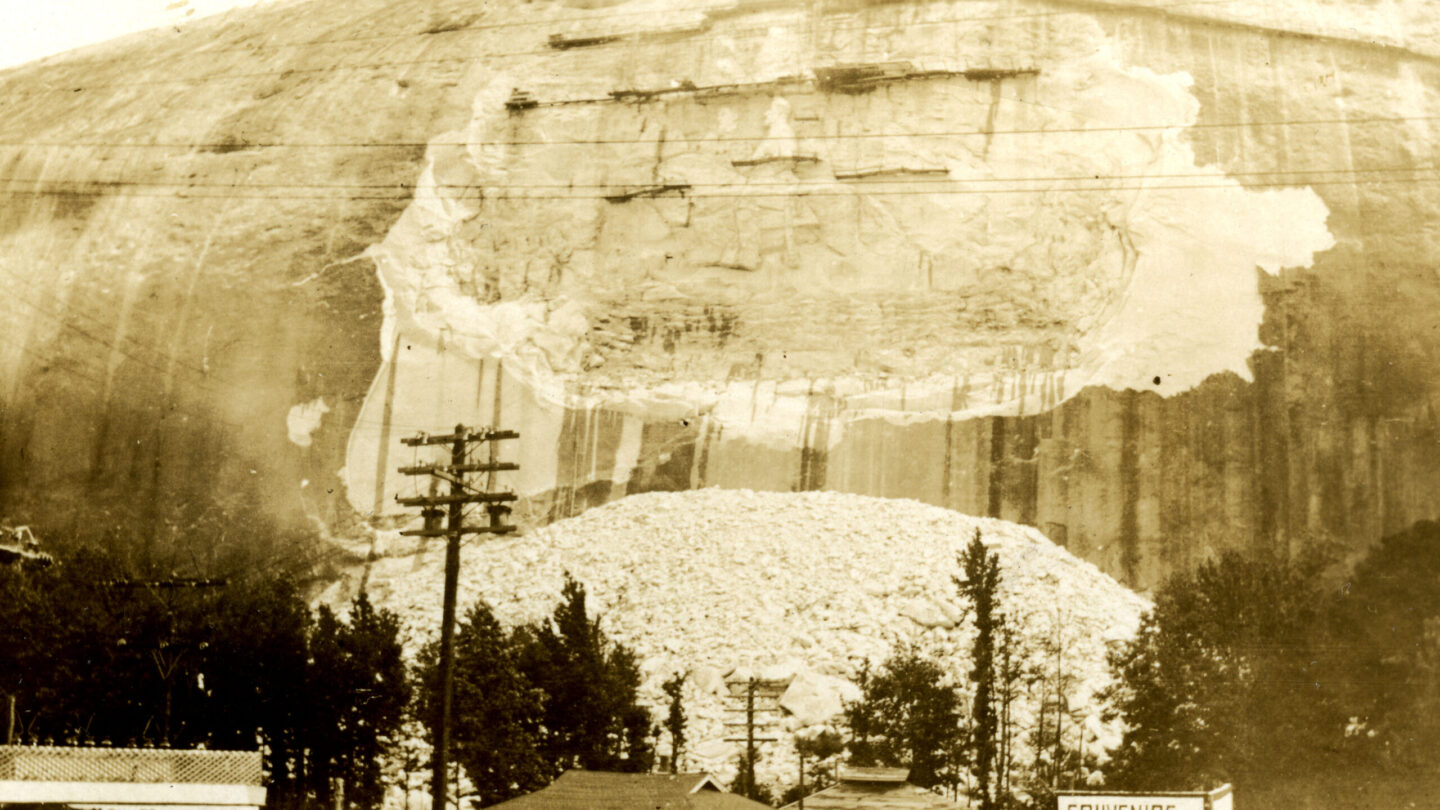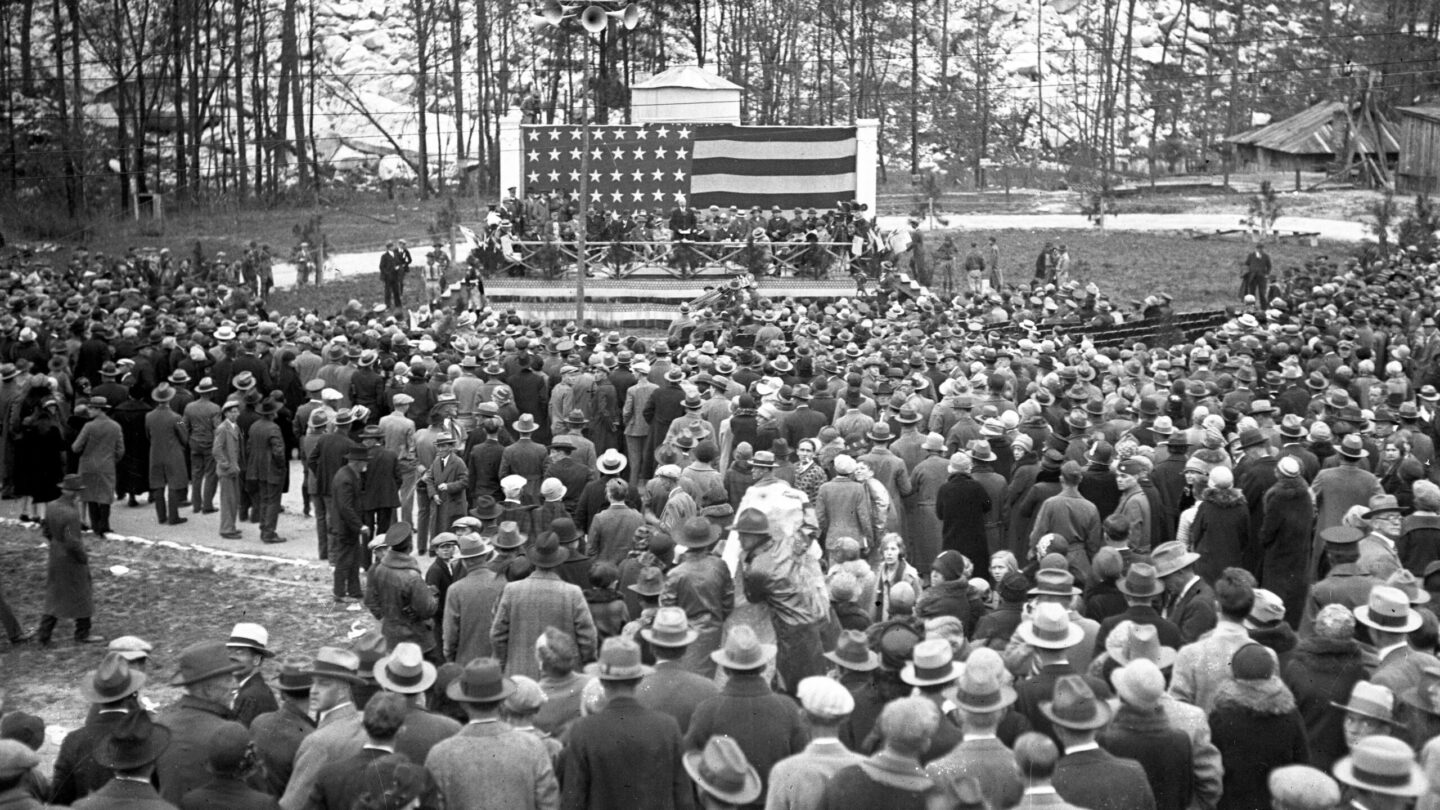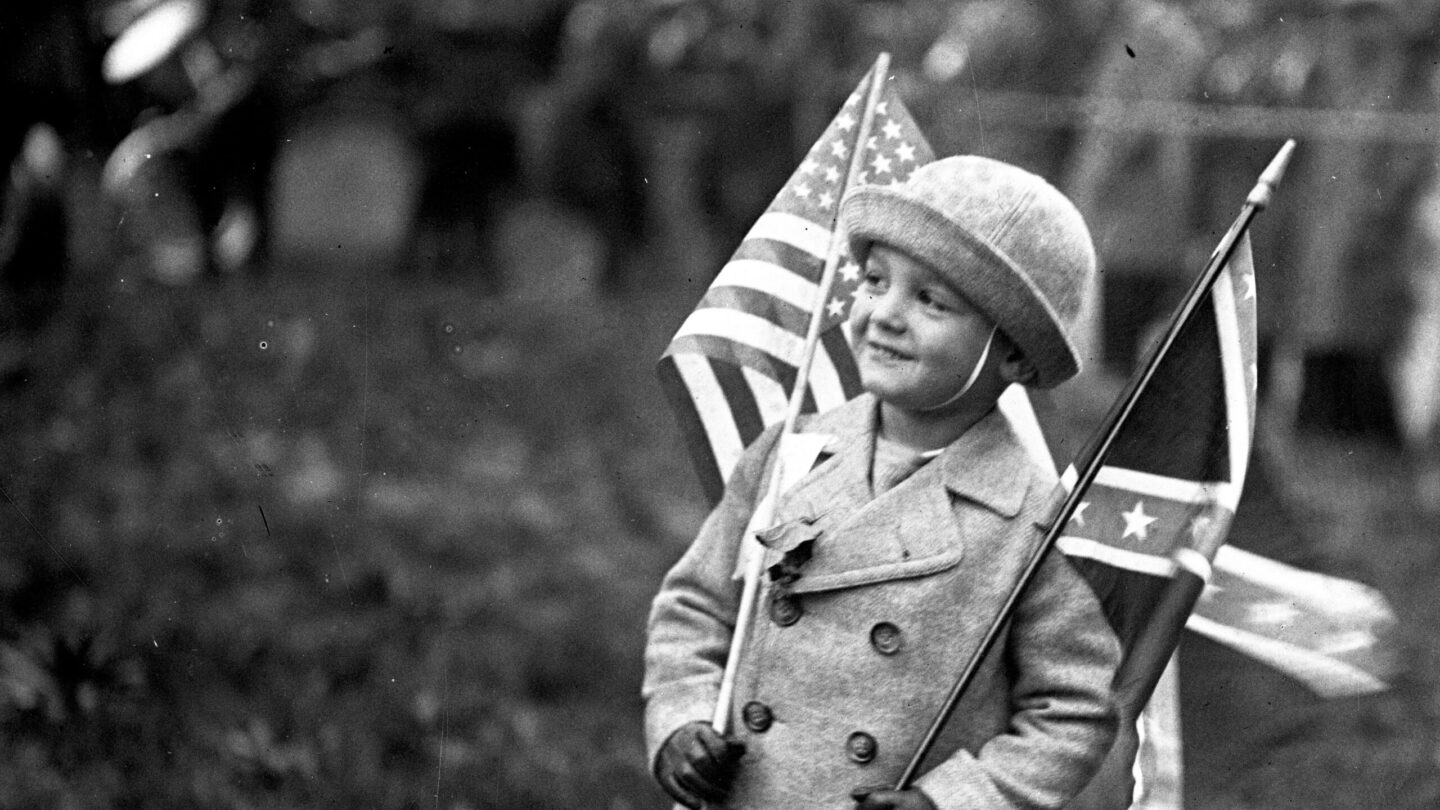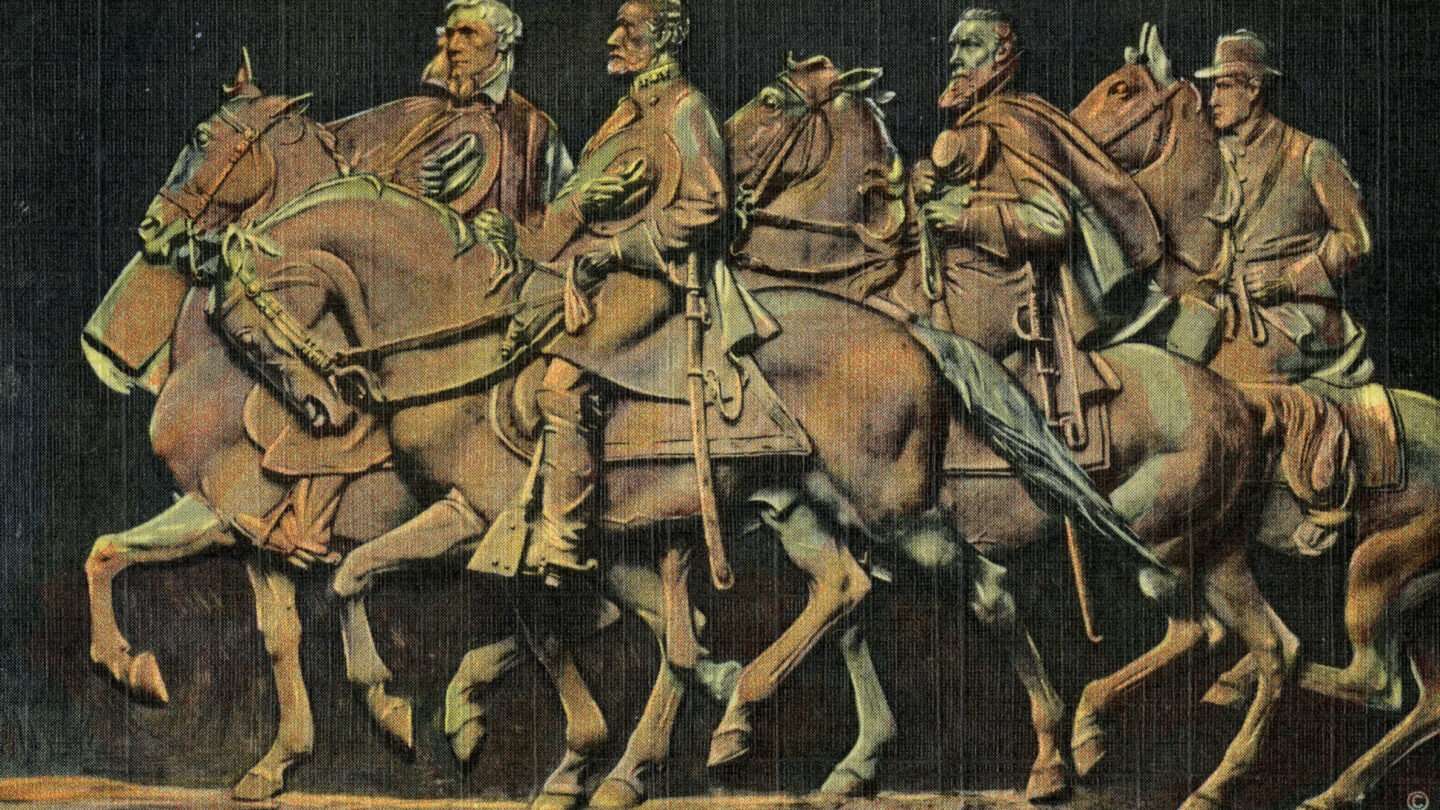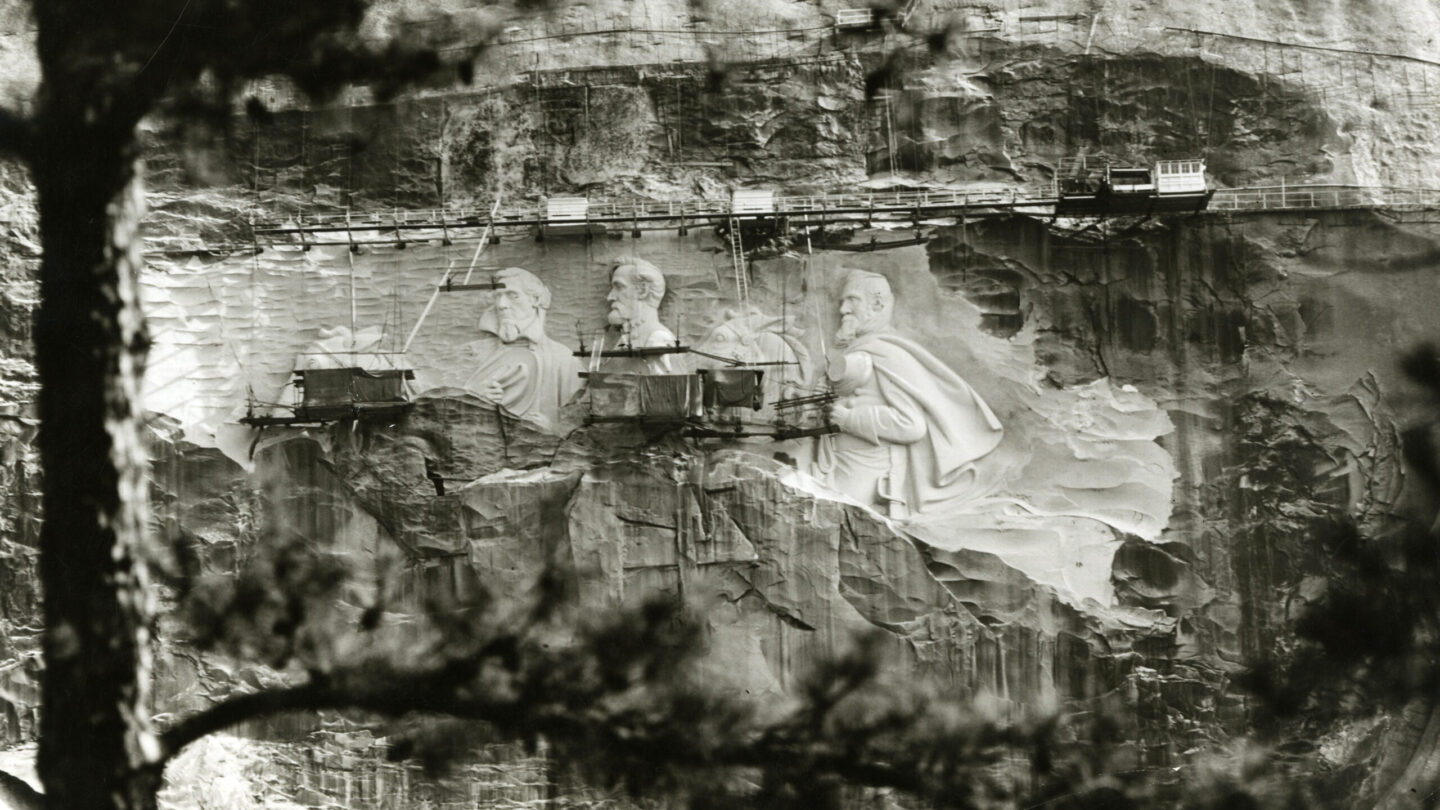Atlanta History Center explores the controversial history of the Stone Mountain carving through a documentary film and online resources.
Monument: The Untold Story of Stone Mountain
The carving on the side of Stone Mountain is the largest Confederate monument in the world.
The mountain is engraved with a sculpture of well-known people from the Confederacy: Jefferson Davis, president of the Confederate states, and generals Robert E. Lee and Thomas “Stonewall” Jackson. Many Georgians recognize the Stone Mountain carving, but few know the full story of its origin.
The effort to create a Confederate monument on Stone Mountain began in the 1910s. Yet, the monument was only completed in 1972. Spanning multiple efforts across more than 50 years, the carving’s history is full of twists and turns.
Today, the mountain and surrounding park remain a large tourist and recreational attraction featuring hiking trails, restaurants, campgrounds, a museum, and occasionally a laser show with the carving as the backdrop.
Atlanta History Center staff have been engaged with the history of the Stone Mountain carving for many years. Over the past year, the institution worked with experts and those closest to the issue to explore the history of the Stone Mountain carving from various perspectives for a documentary. The result of this work is Monument, a documentary film that delves into the controversial history of Stone Mountain, including the origin of the carving and the complicated relationships between historical events and key players who established the monument.
This documentary is designed to inspire deeper learning and conversation about history that we as a state, and a country, share.
The Laws
-
In 1958, the State of Georgia purchased Stone Mountain and adopted the Stone Mountain Memorial Association Act. This law established the Stone Mountain Memorial Association (SMMA) to oversee the completion of the carving and govern the park. The carving was finished 14 years later in 1972. Over time, amendments to the original law, 12-3-190 came to include 12-3-192.1. Georgia Code 12-3-192.1 mandates that the SMMA must “maintain an appropriate and suitable memorial for the Confederacy.”
-
In 2001, Governor Roy Barnes began efforts to change the state flag, which had featured a Confederate battle emblem since 1956. As a part of the compromise with state legislators to remove the Confederate Battle emblem, the legislature amended Georgia Code 50-3-1 (c) to include protection for the Stone Mountain carving specifically. This law also includes text which references Lost Cause mythology.
-
In this section of Georgia code, which defines terms used throughout the entirety of the section of Georgia code that governs Stone Mountain park, the term “project” is defined to mean the operation of Stone Mountain as “a Confederate memorial and public recreation area.”
Panel. Discussion.
Related. Stories.
-
John Temple Graves was a New South orator, newspaper editor, and political figure, known for his influence on racial issues in the late 19th and early 20th century. His newspaper, the Atlanta Georgian, played a significant role in inflaming racial tensions that led to the 1906 Atlanta Race Massacre. He was also one of the earliest proponents of carving the likeness of Robert E. Lee into the side of Stone Mountain as a memorial to the Confederacy.
-
How did the world’s largest Confederate monument end up outside of Atlanta? What should be done, if anything, with it? With these questions in mind, Atlanta History Center explores the controversial history through online resources and an upcoming documentary.
-
The Birth of a Nation’s success and wide distribution increased national interest in the post-Civil War Klan. In Atlanta, the film served as an inspiration and a guide for the leaders of two early 20th-century Atlanta organizations with close connections to Stone Mountain—the modern Ku Klux Klan and the United Daughters of the Confederacy.
-
Originally published in 2017, this document explores the history of the Stone Mountain carving.
Timeline
Archival. Images.
FAQ
In 1915, sculptor Gutzon Borglum envisioned a large group of Confederate soldiers in bas relief (cut out of surrounding stone) marching across the face of the mountain, led by their generals on horseback. By 1923, when carving began, Borglum’s design depicted Jefferson Davis, Robert E. Lee, and Thomas “Stonewall” Jackson in profile on horseback. Two years later, Borglum completed the head of Lee. After Borglum’s dismissal from the project in 1925, sculptor Augustus Lukeman retained Borglum’s basic design, but on a smaller scale. The Stone Mountain Confederate Memorial Association blasted Borglum’s head of Lee off the mountain. Lukeman roughed in the three generals and the upper parts of the horses before his work was stopped in 1928 due to a lack of funds. In 1958, the state of Georgia purchased Stone Mountain with the intention of restarting the carving. Atlanta sculptor Julian Harris proposed finishing the work rather than adopting a completely new design. Ultimately, sculptor Walter Hancock and chief carver Roy Faulkner retained the basic Borglum-Lukeman design but adjusted it for scale.
Defeat in the Civil War came as a shock to many white Southerners. About one-fifth of all white men of military age in the South died because of the war. Richmond newspaper editor Edward J. Pollard coined the phrase “The Lost Cause” in his 1866 book by the same title. Other southern writers, veterans, and women’s memorial organizations soon adopted the term. They explained military defeat as a moral victory because they believed the Confederacy had fought nobly for noble ideals. Some of the key ideas of the Lost Cause are:
-
- The Civil War was fought over state’s rights and economic factors, such as tariffs
- Slavery was not the cause of the Civil War
- Enslaved people benefitted from their condition
- The Confederacy lost only because it did not have enough resources and soldiers
This way of thinking had widespread appeal and popularity among white people in the South and nationally well into the 20th century and even into the present. Historical evidence shows though that the Lost Cause version of the Civil War is inaccurate. Slavery was the primary cause of the Civil War.
It took 58 years for the monument to be completed, though actual carving activity took about thirteen years total, occurring between 1923 to 1928 and 1964 to 1972. In 1914, John Temple Graves of the New York American newspaper proposed that a Confederate monument be carved into the face of Stone Mountain. Rock was first actually chiseled beginning in 1923. However, due largely to internal disputes and lack of funding, the project ground to a halt in 1928. Efforts to revive the project continued unsuccessfully through the Great Depression and World War II. In 1958 the state of Georgia purchased the mountain with the intention of resuming the carving. Carving got underway again in 1964. The monument as we see it today was dedicated in 1970 and officially completed in 1972.
The State of Georgia owns Stone Mountain and the surrounding park, totaling some 3,200 acres. The state purchased this land beginning in 1958 in keeping with Governor Marvin Griffin’s 1954 campaign promise to complete the carving. Prior to that time, Samuel H. Venable and his family owned the land. They leased it to the Stone Mountain Confederate Monument Association between 1916 and 1928 during the initial carving effort.
The two big efforts to carve the Stone Mountain monument happened during important moments in the larger movement for (and by others, against) civil rights for Black and other Americans.
During the early 1920s, the Ku Klux Klan became a national political force in opposing civil rights for Blacks, immigrants, Catholics, and Jewish people. United Daughters of the Confederacy president Helen Plane, leader of the movement to create the monument and inspired by the film The Birth of a Nation, even proposed that Klansmen be featured in the carving. They were not, but the Klan used Stone Mountain itself as a rally and meeting site through the 1950s and the area surrounding the park for years beyond that.
In 1954, the Supreme Court decision in Brown v. Board of Education declared school segregation illegal. This landmark ruling fueled the civil rights movement as Black Americans and allies fought for social integration and equality under the law. Feeling threatened, many white Southerners launched a countermovement often known as “Massive Resistance.” They used Confederate flags and monuments to symbolize their commitment to the “way of life” of racial segregation and white supremacy. Georgia governor Marvin Griffin, who vowed to uphold segregation at all costs, made a campaign promise in 1954, 57 days after Brown vs. Board of Education, to complete the carving of the three Confederate generals on Stone Mountain.
Atlanta History Center is trying to enhance awareness of the history of Stone Mountain Park by providing relevant historical evidence, context, and perspective. The facts behind past events do not change, but the way we find out about them and talk about them does change. For the film, we consulted with subject matter experts with a variety of backgrounds to provide as much clarity as possible on historical facts. Atlanta History Center’s mission is to connect people, history, and culture. We understand that this history can be complicated, challenging, and difficult. We also understand that talking about complex history with empathy and respect for all points of view is the only way to move forward with present-day challenges.
Atlanta History Center does not advocate for any specific policy changes. Stone Mountain is owned by the State of Georgia and belongs to the people of Georgia, so changes (if any) are determined by the state government and the democratic process. We hope this documentary will provide a tool to better understand the history and personal feelings associated with the carving. According to the laws of the State of Georgia, Stone Mountain Park is a Confederate memorial, and the carving of Davis, Lee, and Jackson cannot be altered, removed, or obscured in any way. Two laws governing Stone Mountain Park are GA Code § 50-3-1 and GA Code § 12-3-192.1.
Atlanta History Center has provided a full suite of resources on this webpage, including further reading, citations, and historical documents.
In 2016, Atlanta History Center published the first iteration of this online toolkit, which was designed to help communities address Confederate monuments in their midst. Included in these resources is a white paper on the history of Stone Mountain published in 2017.
Learn moreAtlanta History Center has produced classroom, civic engagement, and family resources for young people from upper elementary to high school.
Learn MoreFilm. Biographies.
Roy E. Barnes knew from a young age what profession he wanted to pursue. His love of law and his commitment to serving others have never wavered.
A lifelong resident of Cobb County, Georgia, Roy Barnes received his undergraduate degree from the University of Georgia and graduated with honors from the Lumpkin School of Law at UGA in 1972. Upon graduation, he went to work as a prosecutor in the Cobb County District Attorney’s office, where he stayed until opening his first law firm in 1975.
For over 40 years, Gov. Barnes has tried civil and criminal cases throughout Georgia and in neighboring states including a successful class action lawsuit against Fleet Finance that received national recognition in the early 1990s. His practice has concentrated primarily on civil litigation, where he has developed an expertise in consumer class action cases, medical malpractice matters, products liability law, general tort matters and commercial litigation. Gov. Barnes has appeared in more than 250 cases in the state and federal appellate courts.
Gov. Barnes has been a public servant nearly as long as he has been a lawyer. At age 26, he was elected the youngest member of the Georgia State Senate. He went on to serve a total of eight terms and was a member of the Appropriations, Rules and Transportation committees. In addition, he was Chairman of the Select Committee on Constitutional Revision, which rewrote the state’s constitution as well as Chairman of the powerful Judiciary Committee. He also served as a floor leader to Governor Joe Frank Harris from 1983 to 1989. After an unsuccessful bid for the Governor’s Office in 1990, he was elected to the State House of Representatives, where he served for six years and was Vice Chairman of the Judiciary Committee and Chair of the Subcommittee on General Law.
In 1998, Barnes was elected to serve as the 80th Governor of the State of Georgia. During his term, he concentrated on education reform, health care reform, and remedies for urban growth and sprawl. He created the Georgia Cancer Coalition and served as Chair of the Southern Regional Education Board, the Southern Governor’s Association, and the Education Commission of the States. He was defeated for reelection in large part because of his efforts to change the Georgia flag, a political decision for which he was honored with the 2003 John F. Kennedy Library Foundation Profile in Courage Award.
From the day he was elected governor, Roy Barnes knew he would return to the practice of law, which he has done through the establishment of The Barnes Law Group.
Donna Faulkner Barron is the oldest daughter of Roy Faulkner, Chief Carver of the Confederate Memorial Carving at Stone Mountain Park. Donna was born to Roy and Juanita in Crawford Long Hospital in Atlanta and was raised in Covington, Georgia with her three other siblings, Richard, the oldest and the only son along with sisters Judy and Patti. Donna is married to Ronald Peter Barron and they have two children, Jessica 34 and Peter 28. Donna completed her elementary and high school years in Newton County and furthered her education by attending Dekalb Area Tech in Clarkston, Ga where she completed her degree in Secretarial Science. Donna was now ready for the work force. She interviewed and was hired as a Stenographer for the Georgia State Labor Department where she worked for 5 years. Realizing that this career was ending, she moved back home and began her new adventure in life…being her dad’s assistant. She helped compile records using her secretarial skills and in the mid 80’s she found herself as the secretary to her dad who was the Curator of the Stone Mountain Carving Museum.
Karen L. Cox is a professor of history at the University of North Carolina at Charlotte, an award-winning historian, and a Distinguished Lecturer for the Organization of American Historians. She is the author of four books, the editor or co-editor of two volumes on southern history and has written numerous essays and articles. Her books include Dixie’s Daughters: The United Daughters of the Confederacy and the Preservation of Confederate Culture, Dreaming of Dixie: How the South Was Created in American Popular Culture, and Goat Castle: A True Story of Murder, Race, and the Gothic South. Her most recent book is No Common Ground: Confederate Monuments and the Ongoing Fight for Racial Justice, which was published in 2021, won the Michael V.R. Thomason book prize from the Gulf South Historical Association.
A successful public intellectual, Dr. Cox has written op-eds for the New York Times, the Washington Post, CNN, TIME magazine, Publishers Weekly, Smithsonian Magazine, and the Huffington Post. She’s given dozens of media interviews in the U.S. and around the globe on the subject of southern history and culture, especially on the topic of Confederate monuments. Dr. Cox appeared in Henry Louis Gates’s PBS documentary Reconstruction: America after the Civil War, Lucy Worsley’s American History’s Biggest Fibs for the BBC, and the Emmy-nominated documentary The Neutral Ground, which examines the underlying history of Confederate monuments and their removal in New Orleans.
Joseph Crespino is the Jimmy Carter Professor of History at Emory University. He is an expert in the political and cultural history of the twentieth century United States, and of the history of the American South since Reconstruction. His research has been supported by fellowships from the National Endowment for the Humanities and the National Academy of Education. In 2014, he served as the Fulbright Distinguished Chair in American Studies at the University of Tubingen, and he has been named a Distinguished Lecturer by the Organization of American Historians. Crespino has published three books, has co-edited a collection of essays, and has written for academic journals as well as for popular forums such as the New York Times, the Washington Post, Politico, and the Wall Street Journal. His most recent book— Atticus Finch: The Biography—Harper Lee, Her Father, and the Making of an American Icon—was published in 2018 by Basic Books.
F. Sheffield Hale is President and CEO of the Atlanta History Center. Prior to joining the Atlanta History Center in 2012, he served as Chief Counsel of the American Cancer Society, Inc. and was a Partner practicing corporate law in the firm of Kilpatrick Townsend LLP. Mr. Hale serves as a Trustee of the Partners for Sacred Places, Midtown Alliance, the Buckhead Coalition, and the Atlanta Convention and Visitors Bureau. He is a member of the Advisory Board of both the Museum of Early Southern Decorative Arts and the Center for the Study of the American South. He is Trustee Emeritus of the National Trust for Historic Preservation and a Past Chair of the Georgia Trust for Historic Preservation, the Atlanta History Center, St. Jude’s Recovery Center, Inc., and the State of Georgia’s Judicial Nominating Commission. He was the Chair of the City of Atlanta Cyclorama Task Force and the Co-Chair of the Advisory Committee on City of Atlanta Street Names and Monuments Associated with the Confederacy. Mr. Hale was a recipient of the 2021 Georgia Governor’s Award for Arts & Humanities. Mr. Hale received his B.A. in History from the University of Georgia summa cum laude in 1982 and his J.D. in 1985 from the University of Virginia School of Law. He is a member of the American Law Institute.
As Vice President of Democracy Initiatives and Author Programs of Atlanta History Center, Claire leads the development and coordination of the Democracy Initiative and a variety of programs and partnerships at Atlanta History Center, including author talks, dialogue series, and more. She joined Atlanta History Center in 2017 as a research and writing assistant. She then pursued opportunities to expand her expertise in communications and special projects, taking an active role in developing the institution’s new Strategic Plan and leading involvement in the national history and civics initiative Made By Us, among other projects. Claire graduated from the honors program at the University of Georgia with a B.A. in History and a B.A. in International Affairs, summa cum laude.
Gordon L. Jones is the Senior Military Historian and Curator at the Atlanta History Center, where he has worked since 1991. He is responsible for the care and interpretation of more than 12,000 objects relating to the American Civil War era, including the DuBose, Dickey, and Wray Collections.
Gordon led the completion of a five-year project to move, restore, and exhibit the 1886 cyclorama painting, The Battle of Atlanta and curated the accompanying exhibition, Cyclorama: The Big Picture. He curated the 9,200 square-foot permanent exhibition Turning Point: The American Civil War as well temporary exhibitions on a variety of subjects. He is the author of Confederate Odyssey: The George W. Wray Jr. Collection at the Atlanta History Center (UGA Press, 2015).
Gordon holds an M.A. in Public History from the University of South Carolina and a Ph.D. from the Graduate Institute of the Liberal Arts at Emory University where he specialized in Civil War memory, performance, and popular culture.
Brent Leggs is the founding executive director of the African American Cultural Heritage Action Fund, the largest preservation campaign in U.S. history on behalf of historic African American places, and a Senior Vice President of the National Trust for Historic Preservation. Through the Fund, he leads a national community of leaders, preservationists, and activists to preserve the memory and legacy of Black American identity. Since the Fund launched in 2017, Mr. Leggs and his team have secured nearly $85 million, supported 200 preservation projects nationwide, and established a $14 million endowment to sustain the Fund’s future. Described as the man who “spends time thinking in centuries” by the New Yorker, Mr. Leggs work is rooted in telling the nation’s full history – mitigating the erasure of African American cultural heritage and reconstructing national identity. In June 2022, as part of the “Future Rising” series sponsored by Hearst Magazines and Lexus, Ms. Oprah Winfrey named Mr. Leggs one of the 50 Black trailblazers changing our world. Mr. Leggs is also an Associate Professor of the Graduate Program of Historic Preservation and Senior Advisor to the Center for the Preservation of Civil Rights at the University of Pennsylvania’s Weitzman School of Design.
Genesis Reddicks is an honors journalism major and African American Studies/Africology minor at Temple University. She was raised by two educators who immigrated to the US from Jamaica. She wants to pursue a career in international journalism giving her a chance to travel the world and learn more about different cultures and societies. Throughout her life, Genesis has dedicated herself to racial justice and equity. In high school, she was a part of the effort to place a marker near her high school, retelling the events of Dr. Martin Luther King Jr.’s trial in her hometown, ultimately creating monumental change in the 1964 US presidential election. She was also a founding member of the Student Coalition of Equity at her high school, which advocated for protection for students of marginalized backgrounds. She was awarded Hometown Hero by the mayor of her hometown in Decatur, Georgia. At her high school graduation, Genesis received the Atlanta Journal-Constitution All-Round Senior, an award given to a single senior of a graduating class. At the moment, Genesis is living her college experience with three jobs, while also being an opinion writer for Her Campus Temple chapter. Although based in Philadelphia for school, Genesis will always call herself a proud Southerner.
Dr. Cynthia Neal Spence is an Associate Professor of Sociology at Spelman College and Director of the UNCF/Mellon Programs. Her teaching and research interests in the areas of sociology, criminology, law and social justice and violence against women support the Law and Criminology concentration in the Department of Sociology and Anthropology. Her interest in issues of higher education access, service-learning, criminal justice reform, gender role socialization and violence against women frame her research, writing, community service involvement and public speaking. In honor of the 50th anniversary of the Kerner Commission, she served as a co-author of “How Does It Feel to Be a Problem? Black Riots and Civil Disorders vs White Rejection and Protest.”
Dr. Spence also serves as the Director of the Spelman College Social Justice Fellows Program. The Social Justice Program is a living and learning community program that attempts to match students’ intellectual interests with their social justice advocacy passions. She is committed to helping Spelman women fully actualize their commitment to “making a choice to change the world” through social justice advocacy. Dr. Spence serves as the Director of the Truth, Racial Healing and Transformation Center, an initiative sponsored by the American Association of Colleges and Universities.
As Director of the UNCF/Mellon Programs, Dr. Spence creates, manages and oversees a suite of future faculty development and faculty career enhancement programs for UNCF (United Negro College Fund) students and faculty. Under her leadership, students are groomed to enter the Ph.D. pipeline and faculty throughout the UNCF consortium are supported in their development as teachers and scholars. The UNCF/Mellon Programs are headquartered at Spelman College.
She has served as consultant for the Ford Foundation Institutional Transformation Project, the University of Chicago Provost Initiative on Minority Affairs, the Agnes Scott College Center for Teaching and Learning and the Georgia Department of Corrections. She completed a two term appointment as Faculty Trustee on the Spelman College Board of Trustees and is the former chair of the Board of the non-profit agency Men Stopping Violence and former Chair of the Board of Directors of Georgia Women for Change (now the Women’s Policy and Advocacy Group of the YWCA of Greater Atlanta). She is a Founding Member of the Women’s Solidarity Society for the Center for Civil and Human Rights.
Dr. Spence has served in the capacities of Assistant Dean for Freshman Studies, Associate Academic Dean and Academic Dean at Spelman College. She is a graduate of Spelman College and earned both the Masters and Ph. D. degrees in Criminal Justice with a special concentration in law from Rutgers University.
Dr. Spence is a graduate of Spelman College where she earned her B.A. degree. She earned both the Masters and Ph.D. degrees from Rutgers University.Additional. Reading.
Film. Citations.
- “Stone Mountain Park opens.” WSB-TV, May 9, 1970. WSBN59602, Walter J. Brown Media Archives and Peabody Awards Collection, University of Georgia Libraries.
- Midnight Session of top of Stone Mountain. May 6, 1922. Uncatalogued Collections, Kenan Research Center at Atlanta History Center.
- “People in Camera.” May 8, 1434.23, Pathe Newsreels, British Pathé.
- “Defend the Monument Rally takes over Downtown Stone Mountain.” Atlanta News First YouTube Channel, August 16, 2020. https://youtu.be/DWW4Ui6iGak
- “Tense day at Stone Mountain as rival protests amass.” 11Alive YouTube Channel, August 15, 2020. https://youtu.be/VcPUL3LWM0k
- “Georgia House Approves Stone Mountain Purchase.” The Butler Herald. February 20, 1958. Georgia Historic Newspapers, Digital Library of Georgia.
- “People Must Unite to Block Integration, Griffin Warns.” Shreveport Times. February 24, 1956. com.
- “WSB-TV newsfilm clip of Marvin Griffin giving a speech about the U.S. Supreme Court decision regarding segregation, 1954 or 1955.” WSB-TV, circa 1954. WSBN38935, Walter J. Brown Media Archives and Peabody Awards Collection, University of Georgia Libraries.
- “‘White power’ rally turns violent at Stone Mountain.” WSB-TV YouTube Channel, April 24, 2016. https://youtu.be/l7G8DBK522c
- The Carving on Stone Mountain. Gacenter_2849, Georgia Center Film and Videotape Collection, University of Georgia Libraries.
- “State Officials Watch Stone Mountain Improvements from Sky-Cable.” WSB-TV, Unknown Date. WSBN38069, Walter J. Brown Media Archives and Peabody Awards Collection, University of Georgia Libraries.
- Battle of New Hope Church. Circa 1895. VIS 2714.001, Atlanta History Photograph Collection, Kenan Research Center at Atlanta History Center.
- “Surrender of Gen. Lee! The Year of Jubilee has come! Let all People Rejoice!” Unknown Newspaper, Circa 1865.
- Roche, T.C., Photographer. Dead Confederate soldier in the trenches. April 2, 1865. Prints and Photographs Division, Library of Congress.
- Barnard, George, Photographer. Ruins of Rolling Mill and cars destroyed by rebels on evacuation of Atlanta. Digital Commonwealth.
- Roche, T.C., Photographer. Dead Confederate soldier in the trenches. April 2, 1865. Prints and Photographs Division, Library of Congress.
- Mosler, Henry, Artist. The Lost Cause. 1889.01.004, Morris Museum of Art, Wikimedia Commons.
- Roton, Pete, Photographer. Confederate Memorial Ceremony. Circa 1945. VIS 170.2587.001, Atlanta History Center Photograph Collection, Kenan Research Center at Atlanta History Center.
- Rogers, Kenneth, Photographer. Fourth of July, Trenton, Georgia. VIS 82.110.01, Kenneth Rogers Photographs, Kenan Research Center at Atlanta History Center.
- “Peace-Fourth of July 1865.” Harper’s Weekly, 1865. Prints and Photographs Division, Library of Congress.
- Pollard, Edward The Lost Cause; A New Southern History of the War of the Confederates. New York: E.B. Treat; Baltimore, J.S. Morrow, 1867. Library of Congress.
- Macarthy, Harry, C “The Bonnie Blue Flag.” New Orleans: A.E. Blackmar & Bros., 1861. Civil War Sheet Music Collection, Library of Congress.
- H. Buek & Co., Lithographer. Our Heroes and Our Flags. New York: G.H. Buek & Co., 1895. Prints and Photographs Division, Library of Congress.
- O’Sullivan, Timothy H., Photographer. Five generations on Smith’s Plantation, Beaufort, South Carolina. Prints and Photographs Division, Library of Congress.
- “Lost Cause In Granite.” The Saratoga Sun. Kenan Research Center at Atlanta History Center.
- Publisher’s Photo Service. Stone Mountain Memorial Concept. U VIS 170.670.001, Atlanta History Center Photograph Collection, Kenan Research Center at Atlanta History Center.
- Stone Mountain Confederate Monumental Association. “Plaster model of Lee’s head, seven feet high, largest cast of a head ever made, which was reproduced in granite twenty-eight feet high.” Stone Mountain Magazine. 1924. Kenan Research Center at Atlanta History Center.
- Image of Confederate Flag Protest at Stone Mountain. 2020. Kenan Research Center at Atlanta History Center.
- Sale of estates, pictures and slaves in the Rotunda, New Orleans. Print, undated. Prints and Photographs Division, Library of Congress.
- McPherson & Oliver, Photographer. Escaped slave Gordon. April 2, Prints and Photographs Division, Library of Congress.
- Inspection and sale of a negro. Engraving, 1854. Prints and Photographs Division, Library of Congress.
- Kurz & Assault on Fort Sanders. Chicago, IL: Kurz & Allison, Art Publishers, 1891. Prints and Photographs Division, Library of Congress.
- “To be sold.” Unknown Newspaper. April 26, 1760. Prints and Photographs Division, Library of Congress.
- Gibson, James, Photographer. Cumberland Landing, Va. Group of ‘contrabands’ at Foller’s House. May 14, 1862. Prints and Photographs Division, Library of Congress.
- Image of segregated water fountains. 1936. Uncatalogued Collections, Kenan Research Center at Atlanta History Center.
- Civil Rights Demonstration. December 1960. VIS 01.03, 108.01.04, 108.01.05, William Stanford Sr. Photographs, Kenan Research Center at Atlanta History Center.
- “Ku Klux Klan’s Annual National Rally at Stone Mountain for a Day of Speech Making, Weddings and Cross Burning.” WSB-TV, September 1, 1973. WSBN69602, Walter J. Brown Media Archives and Peabody Awards Collection, University of Georgia Libraries.
- Ing, M.B., Illustrator. Carte de ka Caroline and Georgia Pour Servir a l’Histoire Generale des Voyages. 1757.
- A new and accurate map of the province of Georgia in North America. 1779. Geography and Map Division, Library of Congress.
- Tucker & Perkins, Photographer. Confederate Troops. April 26, 1861. VIS 170.987.001, Kenan Research Center at Atlanta History Center.
- Hughes, Hardin, Photographer. Stone Mountain. Unknown Date. VIS 112.59.07, Atlanta Blue Print and Graphics Company Photographs, Atlanta History Center, Kenan Research Center at Atlanta History Center.
- “Mrs. Plane Leading Movement For Monument to Confederacy.” Atlanta Constitution. September 26, 1915.com.
- Carter, Carolyn, Photographer. Stone Mountain. Unknown Date. VIS 112.59.01, Atlanta Blue Print and Graphics Company Photographs, Kenan Research Center at Atlanta History Center.
- “World’s Grandest Monument Waiting in Sight of Us for The Confederate Dead.” Hearst’s Sunday American. July 19, 1914. Rare Book and Special Collections Division, Library of Congress.
- Harris & Ewing, Photographer. Red Cross group. November 1, 1922. Prints and Photographs Division, Library of Congress.
- Holland Studio, Photographer. Atlanta Chapter Delegation, U.D.C. Convention, Albany, Ga. 1930 / Holland Studio, Albany, Georgia. Albany, GA: Holland Studio, 1930. Prints and Photographs Division, Library of Congress.
- Harris & Ewing, Photographer. United Daughters of Confederacy. Kennedy, Mrs. Ludlow, Mrs. Drury Conway, McKinley, Mrs. Roy Weeks, Odenheimer, M Cordelia Powell, Mrs. L.H. 1912. Prints and Photographs Division, Library of Congress.
- Farr, H.R., Photographer. Lynching of MacManus. 1882. Prints and Photographs Division, Library of Congress.
- 1925. Prints and Photographs Division, Library of Congress.
- “Lynching of Lige Daniels.” Postcard, August 3, 1920. Wikimedia Commons.
- Bubley, Esther, Photographer. A Greyhound bus trip from Louisville, Kentucky, to Memphis, Tennessee, and the terminals. Sign at bus station. Rome, Georgia. September 1943. Prints and Photographs Division, Library of Congress
- Delano, Jack, Photographer. At the bus station in Durham, North Carolina. May 1940. Prints and Photographs Division, Library of Congress.
- “Colquitt County Courthouse.” Postcard, Columbus, GA: Colorama, 1893. Digital Library of Georgia.
- Raschau, Photographer. Jefferson Davis Park. July 30, 2016. Wikimedia Commons.
- Image of Liberty County Courthouse. Uncatalogued Collections, Kenan Research Center at Atlanta History Center.
- Andrews, Elisha Benjamin; James, James Alton, Authors. “Unveiling of the Equestrian Statue of Robert E. Lee, May 29, 1890” History of the United States from the Earliest Discovery of American to the Present Time. New York, NY: Charles Scribner’s Sons, 1912. Wikimedia Commons.
- “War Histories Are Unfair To South, Is Claim.” Washington Herald. November 15, 1912. Serial and Government Publications Division, Library of Congress.
- The Invisible Empire. Carousel Films, 1965. Internet Archive.
- Griffith, D.W., Director. The Birth of a Nation. Enoch Producing Co., 1915.
- “Portrait of Samuel Hoyt Venable.” Appleton’s Cyclopaedia of American Biography. January 1, 1924. Wikimedia Commons.
- “Figure of Confederate Veteran Be Carved in Stone Mountain.” The Weekly Banner. January 1, 1915. Georgia Historic Newspapers, Digital Library of Georgia.
- Stone Mountain Confederate Monumental Association. “The Sculptor and His Dream” Stone Mountain Magazine. 1924. Kenan Research Center, Atlanta History Center.
- “Tiny Sculptors Slowly Producing Giant Figures of Great Memorial.” The Sunday Star. March 2, 1924. Serial and Government Publications Division, Library of Congress.
- Stone Mountain. 1928. VIS 170.2024.001, Atlanta History Photograph Collection, Kenan Research Center at Atlanta History Center.
- Front view of section of Stone Mountain, near Atlanta, GA. 1928. Prints and Photographs Division, Library of Congress.
- “The Gray Captain Is on Guard,’ Sculptor Lukeman’s New Stone Mountain Group” Americus Times-Recorder. Serial and Government Publications Division, Library of Congress.
- “Resume Work On Stone Mountain.” Early County News. December 3, 1925. Georgia Historic Newspapers, Digital Library of Georgia.
- Stone Mountain design—outtakes. Fox News, April 20, 1926. Fox Movietone News Collection, Moving Image Research Collections, University of South Carolina.
- “Association Loses Stone Mountain, Venable Says.” The Jackson Herald. October 11, 1928. Georgia Historic Newspapers, Digital Library of Georgia.
- Stone Mountain Memorial. 1925. VIS. 170.2027.001, 170.2028.001, Atlanta History Photograph Collection, Kenan Research Center at Atlanta History Center.
- “Series of WSB-TV newsfilm clips of reporter Gloria Lane talking about some of the attractions at Stone Mountain Park, 1968, August 20.” WSB-TV, August 20, 1968. WSBN54398, Walter J. Brown Media Archives and Peabody Awards Collection, University of Georgia Libraries.
- Bledsoe, John T., Photographer. Little rock, 1959. Rally at state capital. Prints and Photographs Division, Library of Congress.
- “WSB-TV newsfilm clip of Georgia governor Marvin Griffin pledging to maintain segregated schools in Georgia and condemning the presence of federal troops enforcing integration by the “Little Rock Nine” at Central High School in Little Rock, Arkansas from a conference held in Sea Island, Georgia, 1957 September 23.” WSB-TV, September 23, 1947. WSBN33584, Walter J. Brown Media Archives and Peabody Awards Collection, University of Georgia Libraries.
- Anti-integration counter-protestors, Forsyth Street, Atlanta, Georgia, July Atlanta Journal-Constitution, July 1963. Atlanta Journal-Constitution Photographic Archive, Georgia State University Library.
- Anti-integration counter-protestors, Forsyth Street, Atlanta, Georgia, July Atlanta Journal-Constitution, July 1963. Atlanta Journal-Constitution Photographic Archive, Georgia State University Library.
- Thompson, Darrell, Photographer. White demonstrators advocating against the civil rights movement and integration, 1961. Atlanta Journal-Constitution, January 11, 1961. Atlanta Journal-Constitution Photographic Archive, Georgia State University Library.
- Ku Klux Klan 1964. AP, July 11, 1964. Associated Press
- Leffler, Warren K., Photographer. Civil rights march on Washington, D.C./WKL. Prints and Photographs Division, Library of Congress.
- “WSB-TV newsfilm clip of African American students picketing several segregated stories in downtown Atlanta, Georgia, 1960 November 25.” WSB-TV, November 25, 1960. WSBN43154, Walter J. Brown Media Archives and Peabody Awards Collection, University of Georgia Libraries.
- “Series of WSB-TV newsfilm clips of reporter Gloria Lane talking about some of the attractions at Stone Mountain Park, 1968, August 20.” WSB-TV, August 20, 1968. WSBN54398, Walter J. Brown Media Archives and Peabody Awards Collection, University of Georgia Libraries
- “Georgia Assembly Meeting to Strengthen Segregation Statutes.” Southern School News. January 1, 1956. Georgia Historic Newspapers, Digital Library of Georgia.
- “Georgia Legislature at Work on More Bills to Keep Segregation.” Southern School News. February 1, 1957. Georgia Historic Newspapers, Digital Library of Georgia.
- “State Senate Approves New Flag for Georgia.” The Butler Herald, February 9, 1956. Georgia Historic Newspapers, Digital Library of Georgia.
- Jackson, Charles, Photographer. Georgia Flag. Atlanta Journal-Constitution, January 1, 1956. Associated Press Images.
- Rogers, Kenneth, Photographer. Governor Vandiver and Miss Georgia with the state flag at the Seattle World’s Fair, 1962. Atlanta Journal-Constitution, June 8, 1962. Atlanta Journal-Constitution Photographic Archive, Georgia State University Library.
- Rogers, Kenneth, Photographer. Memorial for President John F. Kennedy. Unknown date. VIS 82.137.01, Kenneth Rogers Photographs, Kenan Research Center at Atlanta History Center.
- Laster, Jamar. “House voted to change Georgia flag.” The Red & Black. January 25, 2001. Georgia Historic Newspapers, Digital Library of Georgia.
- Hesse, Dean, Photographer. Image of protest at Confederate Obelisk. June 2020. com, supportmylocalnews.com.
- Mayer, Daniel, Photographer. DeKalb County, Georgia Court House. April 24, 2011. Wikimedia Commons.
- “We are the Beacon Hill Black Alliance for Human Rights.” Beacon Hill Black Alliance for Human Rights. Borg.
- “Take it Down No More Monuments to White Supremacy.” Beacon Hill Black Alliance for Human Rights, June 2020.
- Joshua Sharpe, Journalist and Filmer. Footage of the Decatur Confederate obelisk June 2020.
- Brown, Alex. “DHS students and Georgia Historical Society unveil new historical marker honoring MLK.” Decaturish. April 26, 2021. Decaturish.com.
- Whitehall Street. 1864. VIS 170.636.001, Kenan Research Center, Atlanta History Center.
In the News.
Contact. Us.
Showtimes
Tuesday–Friday: 1:30pm and 2:30pm
Saturday & Sunday: 10:30am, 11:30am, 12:30pm, 1:30pm, 2:30pm
Related. Exhibitions.
-
Atlanta History Center online exhibition: American Democracy: A Great Leap of Faith
-
Atlanta History Center is home to one of the nation’s most comprehensive collections of Civil War memorabilia including a growing number of rare objects identified specifically with African American USCT soldiers and regiments such as a canteen, swords, a rifle, brass drum, knapsack, Bible, badges, a Medal of Honor, and a USCT flag.
-
The Civil War is the decisive turning point in American history. A nation divided against itself before—half enslaved, half free—was reunited. Experience the Civil War through the eyes of soldiers and civilians.
-
This online exhibition explores the African American struggle for full citizenship and racial equality that unfolded in the 50 years following the Civil War.


